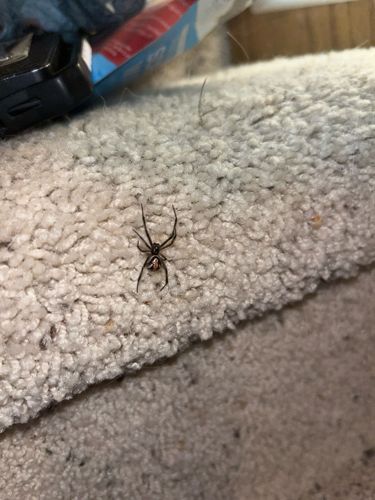Black Widow Spider
Scientific Name: Latrodectus mactans (or other Latrodectus species, as it's hard to distinguish species from this image alone, but it shows characteristic markings of a widow)
Order & Family: Araneae (spiders), Theridiidae (comb-footed spiders)
Size: Females typically have a body length of 13-16 mm (approx. 0.5-0.6 inches); males are much smaller, around 7-9 mm (approx. 0.25-0.35 inches). The spider in the image appears to be a female due to its size and prominent abdomen.

Natural Habitat
Typically found in dark, secluded areas, both indoors and outdoors. Common habitats include woodpiles, under rocks, in sheds, garages, crawl spaces, and undisturbed corners of homes.
Diet & Feeding
Strictly carnivorous, feeding on a variety of insects, such as flies, mosquitoes, grasshoppers, beetles, and occasionally other arachnids. They catch prey using their strong, irregular webs.
Behavior Patterns
Black widow spiders are reclusive and nocturnal. They build irregular, messy, strong webs, often near the ground, for catching prey. Females are known for their venomous bite and sometimes consuming the male after mating, hence the 'widow' name. They are generally not aggressive and will only bite if provoked or threatened.
Risks & Benefits
Risks: The bite of a female black widow spider is venomous and can cause a condition known as latrodectism. Symptoms include muscle pain, abdominal cramps, tremors, and nausea. While rarely fatal to healthy adults, it can be dangerous for children, the elderly, or those with compromised immune systems. Medical attention is usually recommended. Benefits: As predators, they play a role in controlling insect populations, including some pest species.
Identified on: 10/27/2025